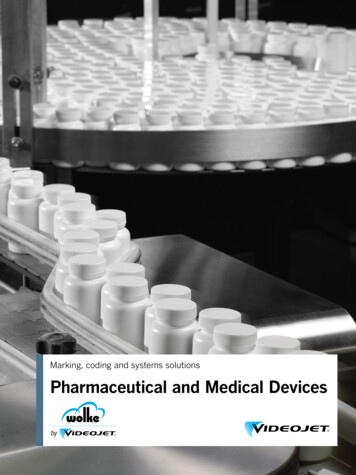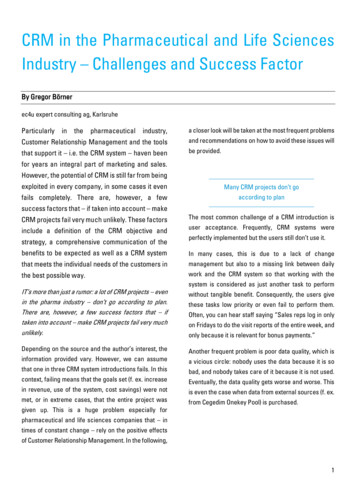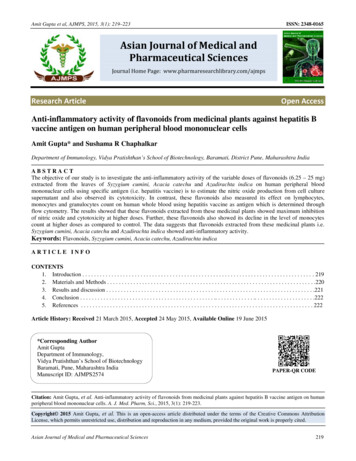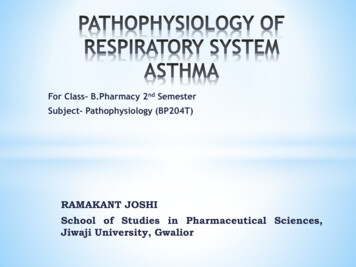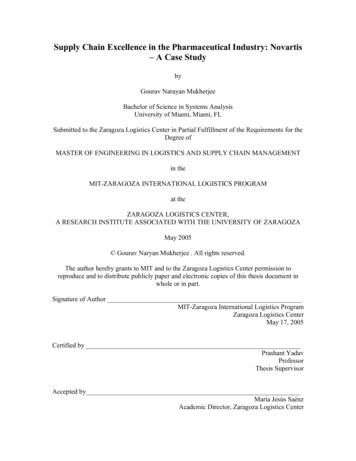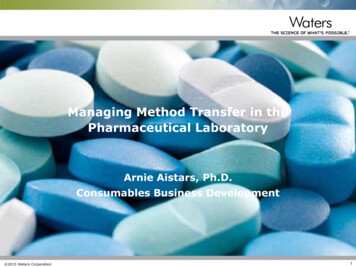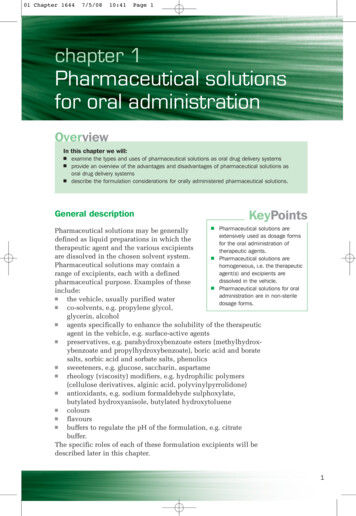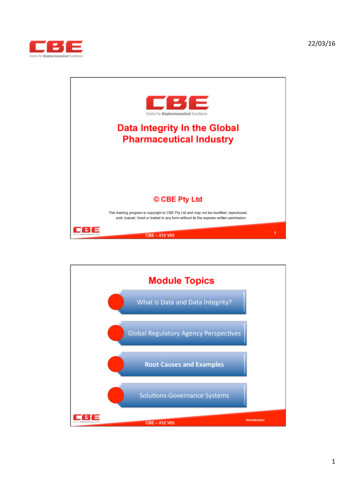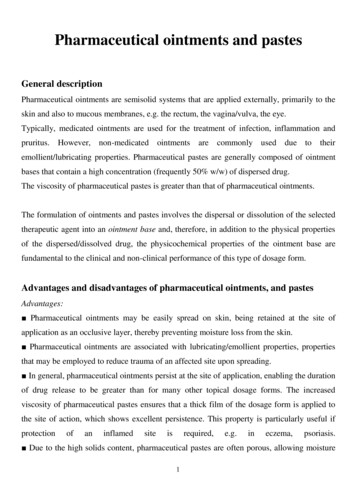
Transcription
Pharmaceutical ointments and pastesGeneral descriptionPharmaceutical ointments are semisolid systems that are applied externally, primarily to theskin and also to mucous membranes, e.g. the rectum, the vagina/vulva, the eye.Typically, medicated ointments are used for the treatment of infection, inflammation andpruritus. However, non-medicated ointments are commonly used due to theiremollient/lubricating properties. Pharmaceutical pastes are generally composed of ointmentbases that contain a high concentration (frequently 50% w/w) of dispersed drug.The viscosity of pharmaceutical pastes is greater than that of pharmaceutical ointments.The formulation of ointments and pastes involves the dispersal or dissolution of the selectedtherapeutic agent into an ointment base and, therefore, in addition to the physical propertiesof the dispersed/dissolved drug, the physicochemical properties of the ointment base arefundamental to the clinical and non-clinical performance of this type of dosage form.Advantages and disadvantages of pharmaceutical ointments, and pastesAdvantages: Pharmaceutical ointments may be easily spread on skin, being retained at the site ofapplication as an occlusive layer, thereby preventing moisture loss from the skin. Pharmaceutical ointments are associated with lubricating/emollient properties, propertiesthat may be employed to reduce trauma of an affected site upon spreading. In general, pharmaceutical ointments persist at the site of application, enabling the durationof drug release to be greater than for many other topical dosage forms. The increasedviscosity of pharmaceutical pastes ensures that a thick film of the dosage form is applied tothe site of action, which shows excellent persistence. This property is particularly useful a,psoriasis. Due to the high solids content, pharmaceutical pastes are often porous, allowing moisture1
loss from the applied site. Furthermore, pastes may act to absorb moisture and chemicalswithin the exudates. The opaque nature of pastes (due to the high solids content) enables this formulation to beused as a sunblock. The chemical stability of therapeutic agents that are prone to hydrolysis will bedramatically enhanced by formulation within pharmaceutical ointments and pastes.Disadvantages: Pharmaceutical ointments are generally greasy and difficult to remove (and are thereforeoften cosmetically unacceptable). Staining of clothes is often associated with the use of pharmaceutical pastes and ointments. The viscosity of pharmaceutical ointments, and in particular pastes, may be problematic inensuring spreading of the dosage form over the affected site. Pharmaceutical ointments may not be applied to exuding sites (however, please note thatthis does not hold for pastes). Problems concerning drug release from pharmaceutical ointments may occur if the drughas limited solubility in the ointment base. Pharmaceutical pastes are generally not applied to the hair due to difficulties associatedwith removal.The choice of ointment base is dependent on several factors, including: (1) the site ofapplication; (2) the required rate of drug release; (3) the chemical stability of the drug; iscosity.1) The site of applicationIn certain clinical conditions the site to which the ointment will be applied may be dry, e.g.psoriasis, or moist. If the area is dry, ointments are often used to occlude the site, therebyretaining moisture. Indeed, this effect is considered to play an important role in the treatmentof certain clinical conditions. Conversely, occlusive ointment bases are not applied to sites inwhich there is fluid exudate.2
2) The required rate of drug releaseFollowing application, the therapeutic agent must be released to exert its pharmacologicaleffect, either locally or, after absorption, systemically. Drug release from the ointment baserequires solubility (albeit partial) of the therapeutic agent within the formulation. This willallow diffusion of the therapeutic agent (a molecular process) through the ointment base untilit reaches the biological substrate. Therefore the choice of the ointment base is partiallydictated by the physicochemical properties (and in particular the solubility) of the therapeuticagent.3) The chemical stability of the drugIf a therapeutic agent is prone to hydrolysis, incorporation into a water-based formulation,e.g. O/W creams, may lead to drug degradation and hence a shortened shelf-life. Thisproblem may be obviated by incorporating the drug into a hydrophobic ointment base. Forexample, the shelf-life of hydrocortisone is markedly greater in an ointment formulation thanin O/W cream formulation.4) The effect of the therapeutic agent on formulation viscosityThe effect of the physical incorporation of a therapeutic agent into an ointment base on therheological properties of the formulated product will be dependent on the required drugconcentration, the physical properties of the therapeutic agent (e.g. particle size, shape) andthe chemical composition and viscosity of the ointment base. Therefore, it is important thatan ointment base is selected that will produce a product that may be readily applied to therequired site. In light of the high drug content, this point is particularly important in theformulation of pastes.Types of base for ointments and pastesThere are four types of base that are used to formulate pharmaceutical ointments and pastes:(1) hydrocarbon; (2) absorption; (3) water-miscible/removable; and (4) water-soluble.3
1-Hydrocarbon Bases (Oleaginous bases): They are water-free, and aqueous preparations may be incorporated into them only in smallamounts. They are used chiefly for their emollient effect because they are retained on the skin forprolonged periods; do not permit the escape of moisture from the skin to the atmosphere. As such they act as occlusive dressings.A-Petrolatum (Yellow Petrolatum, Vaseline) Petrolatum is a mixture of semi-solid hydrocarbons obtained from petroleum. Petrolatum is varying in color from yellowish to light amber. It melts at temperatures between 38 and 60 C. It may be used alone or in combination with other agents as an ointment base.B-White Petrolatum (White Vaseline) It is petrolatum that has been decolorized; it differs only in this respect to petrolatum and isused for the same purpose. White petrolatum is more acceptable to a patient than petrolatum.C-Yellow Ointment (Simple Ointment)Each 100g of Yellow Ointment contains 5 gm of yellow wax and 95gm of petrolatum.D-Mineral Oil (Liquid Petrolatum) It is a mixture of liquid hydrocarbons obtained from petroleum. It is useful as a levigating substance to wet and to incorporate solid substances, e.g., salicylicacid, zinc oxide, into the preparation of ointments that consist of oleaginous bases as theirvehicle.4
2-Absorption Bases:-Absorption bases may be of two types:(1) Those that permit the incorporation of aqueous solutions, resulting in the formation ofW/O emulsions (ex. Hydrophilic Petrolatum and Anhydrous Lanolin).(2) Those that are already W/O emulsions (emulsion bases) and permit the incorporation ofsmall, additional quantities of aqueous solutions (ex. Lanolin and Cold Cream). These bases are useful as emollients—although they do not provide the degree of occlusiveafforded by the oleaginous bases. On the other hand, they are also useful pharmaceutically toincorporate aqueous solutions of drugs, e.g., sodium sulfacetamide, into oleaginous bases.(1) a-Hydrophilic Petrolatum It is composed of cholesterol, stearyl alcohol, white wax, and white petrolatum. It has the ability to absorb water, with the formation of W/O emulsion.(1) b- Anhydrous Lanolin Anhydrous Lanolin is insoluble in water, but mixes without separation with about twice itsweight of water. The incorporation of water results in the formation of a W/O emulsion. Although its rancid odor is offensive, this base finds particular use as a vehicle for theapplication of compound tincture of benzoin and sucrose to treat bedsores.(2)- a- LanolinLanolin is a semisolid, fat-like substance obtained from the wool of sheep. It is a W/Oemulsion that contains between 25 and 30 % water. Additional water may be incorporatedinto lanolin by mixing.(2)-b-Cold Cream It is a semisolid, white, W/O emulsion prepared with Cetyl esters wax, white wax, mineraloil, sodium borate, and purified water. The sodium borate combines with the free fatty acids present in the waxes to form sodiumsoaps that act as the emulsifiers and makes the W/O emulsion stable. Cold Cream is employed as an emollient and ointment base.5
3-Water- miscible/removable Bases: They are O/W emulsions that are capable of being washed from skin or clothing with water. These bases, which resemble creams in appearance, may be diluted with water or withaqueous solutions. From a therapeutic viewpoint, they have the ability to absorb serous discharges indermatologic conditions. Certain medicinal agents may be better absorbed by the skin when present in a base of thistype than in other types of bases.-Hydrophilic Ointment It contains sodium lauryl sulphate as the emulsifying agent, with stearyl alcohol and whitepetrolatum representing the oleaginous phase of the emulsion and propylene glycol and waterrepresenting the aqueous phase. Methyl paraben and propyl paraben are used to preserve the ointment against microbialgrowth.4-Water-soluble Bases: Unlike, water-removable bases, which contain both water-soluble and water-insolublecomponents, water soluble bases contain only water-soluble components. They are commonly referred to as "greaseless" because of the absence of any oleaginousmaterials. Because they soften greatly with the addition of water, aqueous solutions are not effectivelyincorporated into these bases, thus, they are better used for the incorporation of non-aqueousor solid substances. They are prepared by blending macrogols (poly ethylene glycol (PEG)) of high and lowmolecular weights.6
5 2-Absorption Bases: -Absorption bases may be of two types: (1) Those that permit the incorporation of aqueous solutions, resulting in the formation of W/O emulsions (ex. Hydrophilic Petrolatum and Anhydrous Lanolin). (2) Those that are already W/O emulsions (emulsion bases) and permit the incorporation of small, additional quantities of aqueous solutions (ex. Lanolin and Cold Cream).
